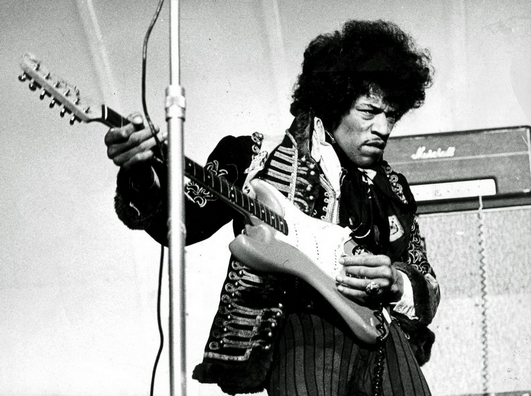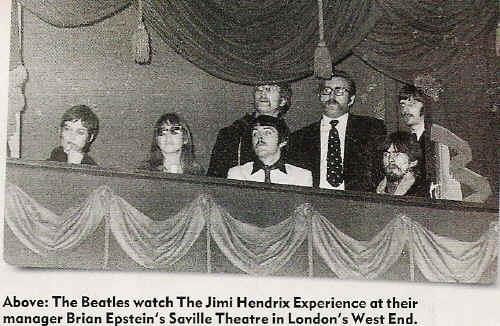A birthday is a one in 365 chance, and I’ve always been chuffed to share mine with two icons of popular culture: Bruce Lee and Jimi Hendrix. It was always tempting to romanticise that, inevitably, I’d develop an affinity for martial arts or rock guitar and, not being much cop at Wing Chun, one out of two isn’t bad!
Both men still command an unwavering hold on the public consciousness, decades after their premature passing. Hendrix’s revenues of over $10 million in the last year, somewhat morbidly rank him 9th on the list of highest earning dead celebrities.
So (and bear with me on this!), I thought I’d mark the occasion of Jimi’s 71st birthday by exploring what made (and continues to make) his appeal so enduring, and how it relates to the business of content marketing.
1983… (A Merman I Should Turn to Be)
It’s no secret that the way to get ahead in SEO is to create great content and linkable assets. Your initial awareness of that content is likely to be through an intriguing and thought-capturing title; in the SERPs, for example, or from an index on a blog.
The subtitle, above, is the name of a song from Hendrix’s equally imaginatively-titled Electric Ladyland album and, if you’re anything like me, upon reading it you’ll instantly want to know what it sounds like.
Overly sensationalist titles can lead to disappointment if the content doesn’t match their promise but, in his four-year career, Hendrix released only the most perfect content he could, even at the expense of losing his manager.
Take 43
Gypsy Eyes, another track from Electric Ladyland, was recorded (to various stages of completion) an astonishing 43 times.
While it’s easy to empathise with the frustration of Chas Chandler, former Animals bassist and Hendrix’s manager before leaving the studio that day, Jimi’s strive for perfection was admirable.
To the reader, the smallest error can devalue a potentially great piece of content, so it pays dividends to reread and redraft your content until you’re fully satisfied with it. Ask others to do the same as constructive criticism, while sometimes hard to receive, could obliviate the need for a further 42 takes!
Room for improvement
It’s hard to imagine Jimi Hendrix having ever been stuck for ideas, but the chances are it happened. Never shy of a challenge though, Jimi enthusiastically reinterpreted other artists material, his definitive reworking of Bob Dylan’s ‘All Along the Watchtower’ lauded, even by its author:
“He probably improved upon it by the spaces he was using. I took license with the song from his version, actually, and continue to do it to this day.”
An avid Dylan fan, it’s likely Hendrix saw this cover version as homage to an idol as opposed to competition. Dylan’s plaudits, however, touch on the fact that there’s no shame in taking inspiration from others ideas, providing you can add value, innovate, update, and / or improve on them. Presumably Paul McCartney had similar thoughts the evening The Beatles watched Hendrix cover Sgt. Pepper just days after its release:
“The curtains flew back and he came walking forward playing ‘Sgt. Pepper’. It’s a pretty major compliment in anyone’s book. I put that down as one of the great honours of my career.”
Influential friends
McCartney’s recommendation that Hendrix play at 1967s Monterey Pop Festival was fundamental in launching Jimi’s career in America, his credibility further boosted by Brian Jones of The Rolling Stones introducing him to the unwitting American crowd.
Endorsements like this, from recognised and revered industry figures, serve to make the impact of your content stronger.
In a PR sense, the association should be mutually beneficial, with the quality of the content reinforcing the experts desire to be involved.
For Hendrix, very little time passed before circumstances turned full circle, producing records for his peers, guesting on other artists’ albums (notably Stephen Stills), and inviting members of Jefferson Airplane, Traffic and The Rolling Stones to collaborate on his.
Worlds Top Musician
Relationships like these, alongside the innate quality of his work, served to create a public perception of Hendrix as an expert in his own right.
Acknowledged by awards from the popular music press, including Disc and Music Echos excellently-titled Worlds Top Musician in 1969 and 1970, Jimi was invited to play on the most sought-after bills, like Woodstock in 1969, and 1970s Isle of Wight festival.
The musical equivalent of the industry conference, Hendrix was essentially gathering exposure for his brand, already synonymous with an overt visual style involving audacious clothing, contortionist showmanship, and vividly-coloured album artwork.
The eye is naturally drawn to that which is visually stimulating, and this certainly applies in content creation. We’re no longer bound by the technological restraints of Hendrix’s era and should exploit every possibility available to us, be it video, audio or photo; no guitar-burning required!




